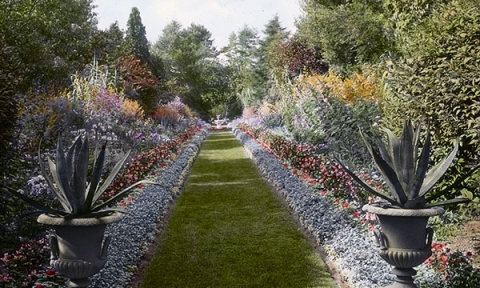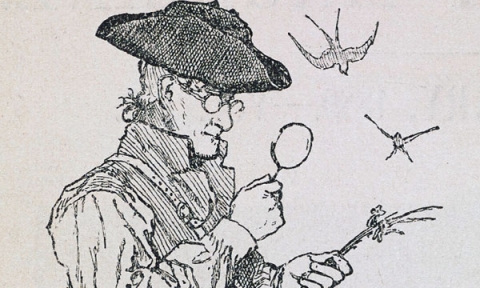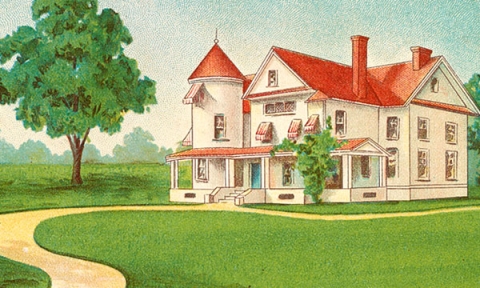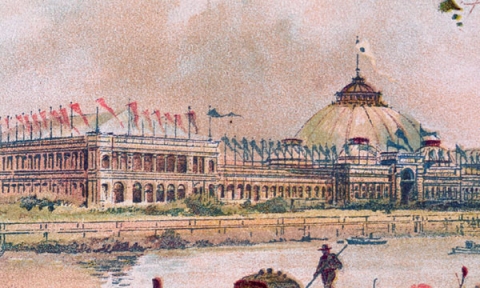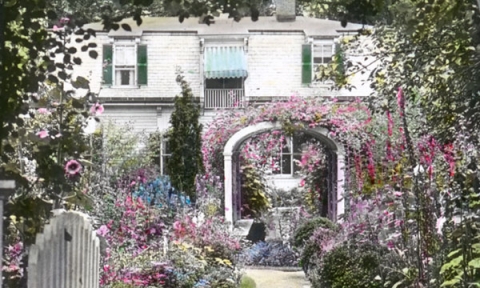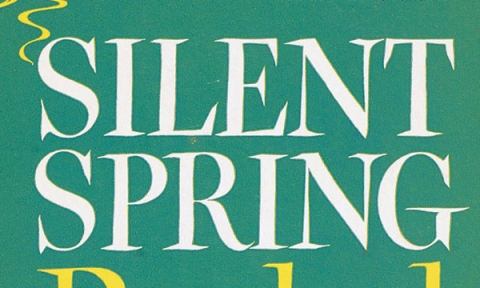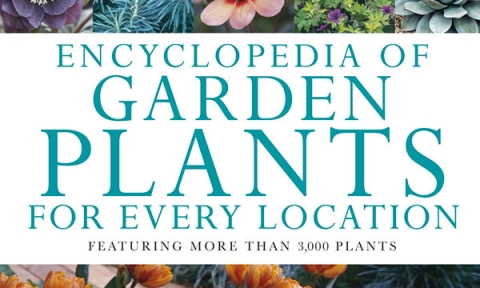Suburban Retreats
For generations, the lure of velvety green lawns has drawn city-dwellers out of the city. America’s love affair with suburban living began in the mid-1800s. Middle-class families moved in increasing numbers to the outskirts of cities to escape crowded and unsanitary conditions.
Ross Bro’s. Co., Farm & Garden Supplies (Worcester, Massachusetts, 1909)
At the same time, improvements to streetcar and railroad transportation made commuting more convenient. The move to the suburbs led to an increased interest in home gardens and landscapes. American homeowners became increasingly devoted to—and obsessed with—their lawns.
Victorian Suburbs
For the suburban yards of 19th-century America, influential author, landscape designer, and horticulturist Andrew Jackson Downing (1815–1852) recommended adapting the English landscape style. Lawns became a highly desirable garden feature—and a status symbol. Downing popularized the lawn in domestic landscape design and advocated the creation of public parks. His 1841 Treatise was a blueprint for creating beautiful country cottages, or villas, primarily for wealthy Americans.
Andrew Jackson Downing, A Treatise and Practice of Landscape Gardening, Adapted to North America, New York, 1844
Downing presented landscape gardening as a fine art, addressing two different styles: the “Graceful” (smooth flowing lines and a house with classical architecture) and the “Picturesque” (irregular lines with wild and broken patterns and a rustic cottage-style house). Downing favored the Picturesque.
“Graceful” and “Picturesque” landscapes From A.J. Downing, A Treatise on the Theory and Practice of Landscape Gardening, Adapted to North America, New York; London, 1844
Mass production made cast-iron garden furnishings affordable in the late 1800s. Often their patterns embodied an array of nature-based motifs, including ferns, morning glories, berries, and grapevines.
J.W. Fiske Iron Works, Illustrated Catalogue and Price List, New York, about 1910
A.J. Downing recommended that garden furnishings fit their surroundings. Rustic pieces, such as the ones on these pages, were appropriate for “picturesque” spaces. Formal gardens called for more refined items.
Frank J. Scott, The Art of Beautifying Suburban Home Grounds of Small Extent, New York, 1886
A student of A.J. Downing, Frank J. Scott (1828–1919) helped spread an appreciation for “velvety lawns” in America’s suburbs. Recognizing that few Americans could afford to maintain large estates and gardens, he designed landscapes for smaller lots, with kitchen gardens and low-maintenance trees and shrubs.
Connecting lawns in suburban Hershey, Pennsylvania, 1946
Archives of American Gardens, J. Horace McFarland Co. Collection
Once a symbol of wealth in Europe, a well-kept lawn became a common feature of American home landscapes by the late 1800s. While not exclusive to American garden design, the broad expanse of unfenced lawns in 20th-century suburban developments is uniquely American.
Trade card: Woman playing croquet
National Museum of American History, Archives Center, Warshaw Collection of Business Americana
Lawns provided space for the European games that suburban culture embraced in the late 19th century. Lawn games such as tennis, croquet, badminton, archery, and horseshoes enhanced the idea that the suburbs were a place of recreation, relaxation, and refuge apart from the city.
The Rise of the Lawn
Suburban homeowners of the 1800s looked to the wide lawns of English manors as the ideal.
Lawns are not easy to maintain, but the desire for them soon spurred innovation. Lawn mowers first appeared in the 1830s and became relatively inexpensive by the 1880s. A demand soon followed for grass seed, sprinklers, and other lawn supplies, which nurserymen hastened to offer.
Horse-drawn lawn mower
From Peter Henderson, Everything for the Lawn (1897)
Lawn mowers powered by horses, steam, and even tricycles made an appearance, but most did not catch on. Push mowers were preferred until the invention of combustion engines that were small enough to fit on a mower.
Man mowing lawn with a push mower, Bissell Garden, Rochester, New York, 1916
Hand-colored glass lantern slide
Archives of American Gardens, J. Horace McFarland Co. Collection
Seed companies advertised their best blends of grass mixes for perpetually lush green lawns alongside plants, vegetables, and fruits in their trade catalogs.
In the boom years after World War II, American suburbs swelled. A growing middle class now found home buying within their reach. The new (since 1938) 40-hour work week and higher wages meant that more people had more time and money to maintain their homes and gardens.
Small Homes Guide, New York, 1944, Archives of American Gardens
By 1915, the United States Department of Agriculture, working with the U.S. Golf Association, was conducting research to find grasses suited for particular climates and uses. A number of turf grasses from overseas made their way into American lawns.
Timeline: Inventions for the Lawn
-
1830s
First lawn mower patent issued to Edwin Beard Budding in Gloucestershire, England.
-
1850s
First reel mower model built by Thomas Coldwell in Newburgh, New York.
-
1869
Chadborn & Coldwell Manufacturing Company, producer of lawn mowers, founded in Newburgh, New York.
-
1871
First American patent issued for a lawn sprinkler.
-
1890s
Lawn mowers are a standard item in hardware stores and mail order catalogs.
-
1892
Lead arsenate introduced to control gypsy moth outbreaks in New England.
-
1900
Hose reels, nozzles, and sprinklers are widely available in the United States.
-
1903
First gasoline-powered riding mower introduced by Coldwell Lawn Mower Company of Newburgh, New York.
-
1914
William Coldwell, son of Thomas Coldwell, designs America’s first push-type mower.
-
1925
Electric lawn mower patented in America by Alwin Smith. Rights assigned to Coldwell Lawn Mower Company.
-
1928
First rotary mower, called the Pioneer, manufactured by the Louisville Electric Manufacturing Company.
-
1930s
Lead arsenate used extensively on home lawns as an insecticide.
-
1940s and 1950s
Use of DDT (dichlorodiphenyltrichloroethane) on lawns expands.
-
1962
Rachel Carson’s bestseller Silent Spring examines America’s use of pesticides.
-
1971
Weed eater,” also known as “weed whacker,” is invented by George Ballas of Houston, Texas.
-
1972
DDT is banned.

